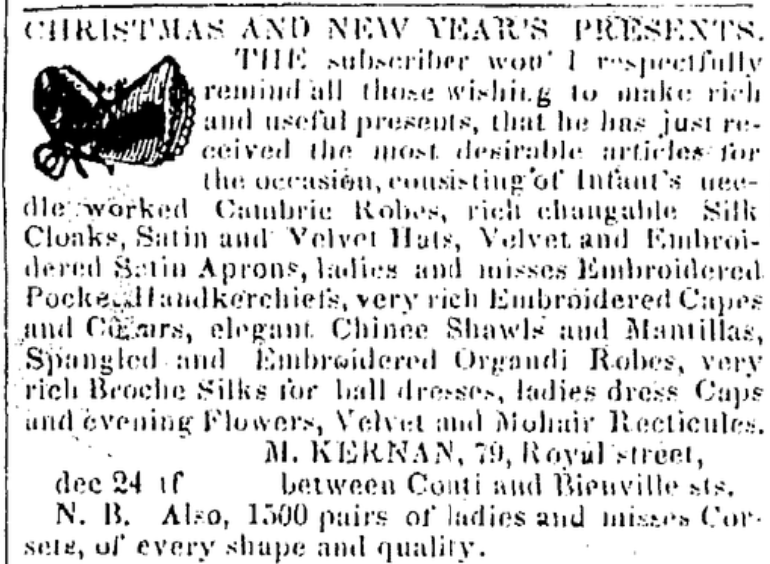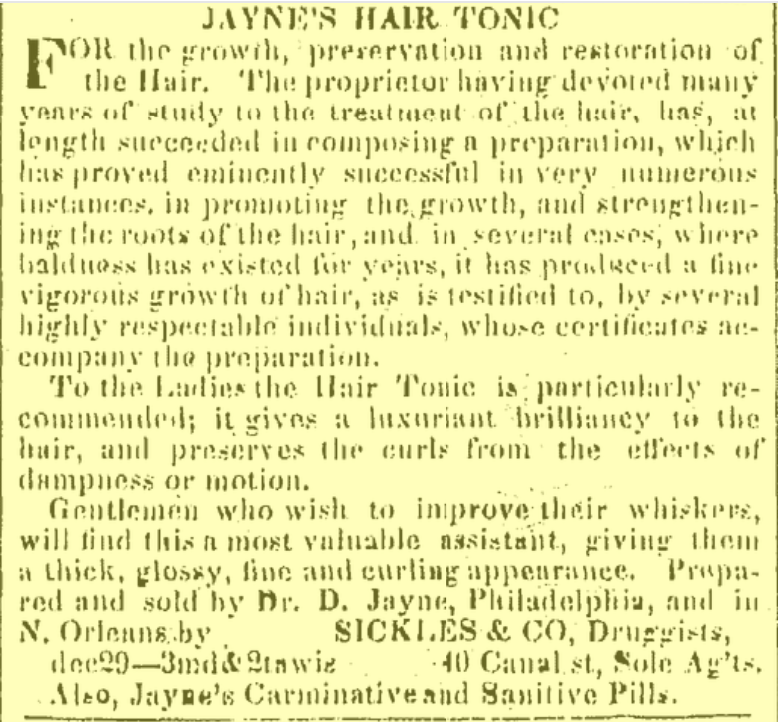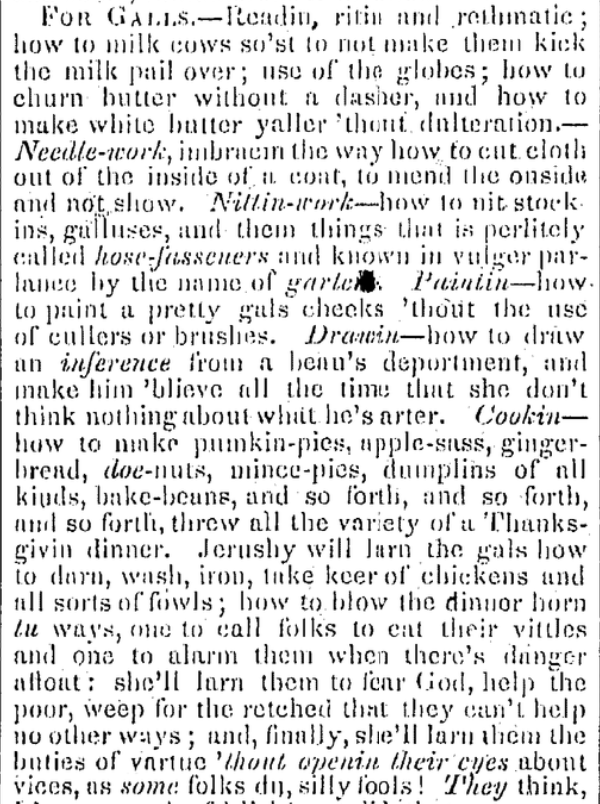In 1841 New Orleans, women were represented in media through advertisements about art classes, housework, and, most importantly, fashion. As shown through the Times Picayune, there were constantly new trends, such as fur and head dresses, coming from France and England that inspired the way southern women dressed. These advertisements were the only way the media related to women, and everything else, such as the sale of cattle and slaves, were addressed or advertised to men. Women’s fashion for 1841 New Orleans represented the oppression of females and the divide in socio-economic status. The uncomfortable corsets, dainty jewelry, and modest necklines were inspired by the idea that women should be fragile and weak. The way the Times Picayune advertises items like Jane’s hair tonic and what new fur is in season helps perpetuate this idea and prove that women are only viewed as houseworkers and objects. The mainstream media also centered around providing information about fashion for the rich and powerful women of the South, rather than women as a whole.
A woman’s reputation meant a great deal at this time, so wearing the proper clothing could depict her worth and show her status in society. Women’s fashion spawned from the later years of the Romantic Era and developed into a more Gothic Revival style. The main style of dresses were hand sewn and had an unnatural shape made by a corset, a long-waisted bodice, tight and narrow sleeves, and a full, dome-shaped skirt that now skimmed the floor. These dresses were usually accompanied by as many as six or seven petticoats in order to maintain a woman’s ladylike image. During this time period, it was considered unladylike to be seen without a covering over one’s dress. This dress style was meant to prove a woman’s place in society and show her modesty in a time where a woman’s virtue meant everything. These fashion norms also created additional problems for women and dictated the way they behaved. In the mornings, it took multiple helpers and an abundance of time for a woman of high reputation to dress herself. This protocol was mandatory to look presentable and reminded women they needed help doing basic tasks like getting dressed in the morning.

Article from the Times Picayune January 1st, 1841
Fashion in New Orleans differed between the socio-economic communities; the elite enjoying the grand, elegant styles. and the poor having to abide to more simplistic designs and fabrics. Lower-class women did not wear wide hoop skirts; they wore coarser fabrics like osnaburg, fustian, linsey-woolsey, and calico. The elite women typically opted for silk, velvet for colder weather, fine lawn, linen, and muslin in warm weather. Large prints were difficult to match and [also] restricted to the wealthy. For a society defined by social hierarchies, being unable to wear the best clothing sets apart the upper and lower class. This gap in fashion and wealth was apparent through the media. The average lower-class woman was able to find information through magazines, but these items had to be purchased separately from the daily paper, where only the wealthy could find advertisements for the new fashion trends imported from Europe.

Article from the Times Picayune January 1st, 1841
Another oppressive aspect of the fashion world was the idea of a pale complexion obtained through an unhealthy lifestyle and using parasols, a fabric umbrella carried on a sunny day to protect a woman’s complexion from the sun. The elite women of the South kept their skin light to avoid being mistaken for someone poor or African American. To a southern woman, nothing seemed worse than having her reputation shattered due to being viewed as inferior because of her skin tone. Despite the amount of free African American women living in New Orleans at the time, a pale complexion was still the beauty standard. Being a woman during this period was already demeaning, but the color of one’s skin could push them farther down.
A woman’s accessories and hairstyle also shaped how they were perceived and were meant to symbolize youth and innocence. The jewelry worn was small, and rose gold was the preference in delicate, dangle earrings and oval, horizontal, or vertical brooches. Fans were also a popular accessory of the American South, a region of hot, humid summers. Simple paddle fans made of palmetto leaves were round and small. Six to ten-inch folding fans were painted with pretty designs. These fans were used for heat protection and to help women flirt innocently. This extra use of allowing women to flirt proved that the items used in a woman’s everyday life were used not for her self gain, but to help prove her worth and entice male suitors. Hair was typically worn parted in the center or with long ringlet curls hanging on either side of the face. These loops could be puffed out with a ‘rat,’ a small net stuffed with hair gathered during brushing. The jewelry, fans, and hairstyles were all meant to display innocence with their delicate aesthetic. Society prioritized virtue and saw women as a prize that they needed untouched. These extra items and aspects of style seem harmless, but they shaped the way women were thought of and created demeaning expectations that didn’t allow them to reach their full potential.

Article from the Times Picayune January 2nd, 1841
Throughout the month of January, the Times Picayune depicts many advertisements meant for women about how to better themselves in a way society believes a woman should. There are classes to teach women to draw, to improve housework, and new beauty and fashion products. Learning to make the perfect pumpkin pie was more important for women than an actual education at this time. In 1840’s America, women’s education was starting to become more accepted and females were believed capable and deserving of common school education. However, this acceptance came from society wanting females to become upstanding moral citizens so they could become good future wives and mothers. Mothers were their children’s first educators, so schooling would allow them to pass solid moral training on to their families. Education for women beyond common school was not publicized. These advertisements only talk about superficial topics and lead a woman to believe that this is all she is good for. Having a perpetual stream of one-dimensional subjects directed at women leaves a toll on their minds, but also shows men that this is how a woman should act. The media leaves an impression on its readers, so having the Times Picayune write about these topics confirmed society’s previous beliefs that women are less than and only needed for frivolous activities.

Article from the Times Picayune January 2nd, 1841
Despite these restrictions and societal norms imposed on women, prostitutes were not required to dress in a sexual manner and were exempt from expectations. Prostitutes were not considered part of mainstream society, and this exclusion was why they escaped the dress codes of society. Most prostitutes were lower-class white Creole women, although they were not alone in this profession. Many immigrant women were forced into prostitution when they arrived in New Orleans without resources or family support. Though many of these women were unwillingly put in this position, they did take the few advantages that came with it. Many of these women cross-dressed as men for Mardi Gras. Mardi Gras is typically a time for a woman to show their breasts, but to negate this sexist construct, these women would dress up as men. Prostitutes were already considered the bottom of the totem pole, so they took their opportunity to penetrate and undermine men’s social superiority over women. They used men’s clothing to express that they did not care about how a stereotypical Southern woman should look and behave. Women such as Sarah Bernhardt stunned people by wearing pants in public and playing the roles of men in the theater, essentially eroticizing cross-dressing. The irony behind these women being looked at for sexual needs and yet using their clothing to rebel completely negates societal etiquette. For women to have some say in their appearance, they must lower their status in society to the point where they sell themselves for money. Only then can they experiment with fashion norms and have some control.
This piece was edited by Anna Blavatnik as part of Professor Kelley Crawford’s Digital Civic Engagement course at Tulane University.
 Earthtalk: “Cool Roofs” for New Orleans
It’s hot outside, but it could be cooler! In this article, Brooke Theis explores Cool Roofs, an effective solution to the urban heat island effect that makes the New Orleans heat so unbearable. The author also explores inequalities in how people experience the environment from identity perspectives like race and class.
Earthtalk: “Cool Roofs” for New Orleans
It’s hot outside, but it could be cooler! In this article, Brooke Theis explores Cool Roofs, an effective solution to the urban heat island effect that makes the New Orleans heat so unbearable. The author also explores inequalities in how people experience the environment from identity perspectives like race and class.
 Big Chem-EZ: How can small Louisiana communities access clean drinking water after a hurricane?
When I went to visit the Pointe-au-Chien tribe after Hurricane Ida with my Service Learning class, I heard that one of the biggest challenges in the aftermath of the hurricane was finding enough drinking water, so in this article, I explore water purification methods: 1) when they are necessary, 2) how they work, and 3) if they really make your water safe to drink.
Big Chem-EZ: How can small Louisiana communities access clean drinking water after a hurricane?
When I went to visit the Pointe-au-Chien tribe after Hurricane Ida with my Service Learning class, I heard that one of the biggest challenges in the aftermath of the hurricane was finding enough drinking water, so in this article, I explore water purification methods: 1) when they are necessary, 2) how they work, and 3) if they really make your water safe to drink.
